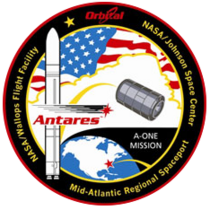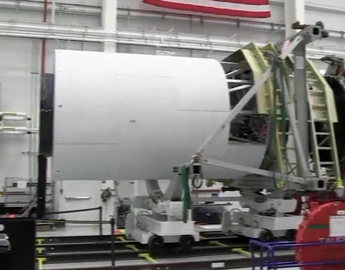Engineering:Antares A-ONE
 The Antares 110 lifts off at the start of the mission | |
| Names | Simulated Cygnus Payload [1] |
|---|---|
| Mission type | Test flight |
| Operator | Orbital Sciences Corporation |
| COSPAR ID | 2013-016D |
| SATCAT no. | 39145 |
| Website | https://news.northropgrumman.com/ |
| Mission duration | 19 days |
| Spacecraft properties | |
| Spacecraft | Cygnus mass simulator |
| Manufacturer | Orbital Sciences Corporation |
| Launch mass | 3,800 kg (8,400 lb) |
| Dimensions | 5.061 m × 2.896 m (16.60 ft × 9.50 ft) |
| Start of mission | |
| Launch date | 21 April 2013, 21:00:00 UTC[2][3] |
| Rocket | Antares 110[4] |
| Launch site | Wallops Pad 0A |
| Contractor | Orbital Sciences Corporation |
| End of mission | |
| Disposal | Deorbited |
| Decay date | 10 May 2013 |
| Orbital parameters | |
| Reference system | Geocentric orbit[5] |
| Regime | Low Earth orbit |
| Perigee altitude | 240 km (150 mi) |
| Apogee altitude | 260 km (160 mi) |
| Inclination | 51.6° |
 Orbital Sciences insignia | |
Antares A-ONE mission was the maiden flight of Orbital Sciences Corporation' Antares launch vehicle including the ascent to space and accurate delivery of a simulated payload, the Cygnus Mass Simulator (CMS), which was launched 21 April 2013.[5] It was launched from Pad 0A at the Mid-Atlantic Regional Spaceport (MARS), Wallops Flight Facility, Virginia.[5] The simulated payload simulates the mass of the Cygnus cargo spacecraft.[5] This dummy payload was sent into an orbit of 240 km × 260 km (150 mi × 160 mi) with an orbital inclination of 51.6°, the same launch profile it will use for Orbital's upcoming cargo supply missions to the International Space Station (ISS) for NASA.[5]
This launch along with several other activities leading up to it, are paid milestones under NASA's Commercial Orbital Transportation Services (COTS) program.[6]
Primary payload
The primary payload was the Cygnus Mass Simulator. It had a height of 5.061 m (16.60 ft), a diameter of 2.896 m (9 ft 6.0 in) and a mass of 3,800 kg (8,400 lb).[7] It was equipped with 22 accelerometers, 2 microphones, 12 digital thermometers, 24 thermocouples and 12 strain gages.[7]
Secondary payloads
Four Spaceflight Industries Inc. CubeSat nanosatellites were deployed from the dummy payload.[8]
The secondary payloads were four CubeSats that were deployed from the CMS.[7] Three of them were PhoneSats, 1U CubeSats built by NASA's Ames Research Center.[7] These were named Alexander, Graham and Bell, after the Alexander Graham Bell, inventor of the telephone.[7] The purpose of these three satellites was to demonstrate the use of smartphones as avionics in CubeSats.[7] They each had a mass of 1,124 kg (2,478 lb) and were powered by lithium batteries.[7] The fourth nanosat was a 3U CubeSat, called Dove-1, built by Cosmogia Inc. It carried a "technology development Earth imagery experiment" using the Earth's magnetic field for attitude control.[7][9]
Mission timeline
- Lift off of the Antares launch vehicle occurs two seconds after the first stage engines are ignited
- The first stage engines shut off 228 seconds after lift-off
- At 233 seconds, the first stage separates from the second
- At 317 seconds, the payload fairing is jettisoned
- At 326 seconds, the second stage's engine is ignited
- At 481 seconds, the second stage is shut off
- At 601 seconds, the Cygnus Mass Simulator separates [5]
| Attempt | Planned | Result | Turnaround | Reason | Decision point | Weather go (%) | Notes |
|---|---|---|---|---|---|---|---|
| 1 | 17 April 2013, 17:00:00 17 Apr 2013, 5:00:00 pm | scrubbed | — | technical | 17 April 2013, 16:44:00 17 Apr 2013, 4:44 pm (T-12:00 hold) | 60% [10] | Premature disconnect of upper stage umbilical cable during T-12:00 hold [11] |
| 2 | 20 April 2013, 18:10 20 Apr 2013, 6:10:00 pm | scrubbed | 3 days, 1 hour, 10 minutes | weather | 20 April 2013, 16:30 20 Apr 2013, 4:30 pm | 90% | [12] |
| 3 | 21 April 2013, 17:00:00 21 Apr 2013, 5:00:00 pm | success | 0 days, 22 hours, 50 minutes | 80% | First flight of Antares [13] |
Gallery
See also
References
- ↑ "Display: Simulated Cygnus Payload 2013-016D". NASA. 27 April 2021. https://nssdc.gsfc.nasa.gov/nmc/spacecraft/display.action?id=2013-016D.
 This article incorporates text from this source, which is in the public domain.
This article incorporates text from this source, which is in the public domain.
- ↑ "Antares A-ONE Mission Coverage". Spaceflight101. 21 April 2013. http://www.spaceflight101live.com/live-antares-a-one-mission.html.
- ↑ Clark, Stephen (20 April 2013). "Antares A-One Mission Status Center". Spaceflight Now. http://spaceflightnow.com/antares/demo/status.html.
- ↑ Bergin, Chris (22 February 2012). "Space industry giants Orbital upbeat ahead of Antares debut". NASASpaceFlight.com. http://www.nasaspaceflight.com/2012/02/orbital-upbeat-ahead-of-antares-debut/.
- ↑ 5.0 5.1 5.2 5.3 5.4 5.5 "Orbital Sciences successfully launches first Antares rocket". Northrop Grumman. 21 April 2013. https://news.northropgrumman.com/news/releases/orbital-sciences-corporation-orbital-successfully-launches-first-antares-rocket.
- ↑ "Space Act Agreement Amendment Seven between NASA and Orbital Sciences Corporation for COTS". NASA. 30 March 2011. https://www.nasa.gov/centers/johnson/pdf/543091main_NNJ08TA32S-Amendment%207.pdf.
 This article incorporates text from this source, which is in the public domain.
This article incorporates text from this source, which is in the public domain.
- ↑ 7.0 7.1 7.2 7.3 7.4 7.5 7.6 7.7 "Antares Test Launch "A-ONE Mission" Overview Briefing". Orbital Sciences. 17 April 2013. http://www.orbital.com/Antares-Cygnus/files/Pre-Launch-Guest-Briefing.pdf.
- ↑ Lindsey, Clark (21 March 2013). "Spaceflight Services installs four nanosats on Antares rocket". NewSpace Watch. http://www.newspacewatch.com/articles/spaceflight-services-installs-four-nanosats-on-antares-rocket.html.
- ↑ "Cosmogia Dove-1 Orbital Debris Assessment Report". FCC. 6 January 2012. https://apps.fcc.gov/els/GetAtt.html?id=122025&x=.
 This article incorporates text from this source, which is in the public domain.
This article incorporates text from this source, which is in the public domain.
- ↑ Orbital Sciences (17 April 2013). "Still marching toward the first launch...". Twitter. https://twitter.com/OrbitalSciences/status/324623442689277953.
- ↑ Orbital Sciences (17 April 2013). "The umbilical was a data cable connected...". Twitter. https://twitter.com/OrbitalSciences/status/324659214272315394.
- ↑ Orbital Sciences (20 April 2013). "#Antares launch attempt scrubbed...". Twitter. https://twitter.com/OrbitalSciences/status/325709552324579328.
- ↑ Harwood, William (21 April 2013). "Antares rocket climbs into space on maiden flight". CBS News. http://www.cbsnews.com/news/antares-rocket-climbs-into-space-on-maiden-flight/.
External links
- Antares Pre-Launch "A-ONE Mission" Briefing
- Antares A-One Mission Overview
- NASA WFF mission page
- Video of Pre-Flight Press Conference - Part 1 - YouTube (NASA TV)
- Video of Pre-Flight Press Conference - Part 2 - YouTube (NASA TV)
- Video of Antares A-One being rolled out to launch pad - YouTube (NASA TV)
- Video of the launch of the Antares A-One Mission - YouTube (NASA TV)
 |





